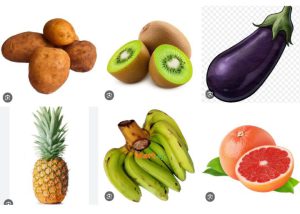
In all likelihood, the first thing you do when you eat an orange is tear off that thick peel and throw it straight into the garbage.
Guess what? You’re missing out on a lot of nutrients. The peel of an orange has nearly twice as much vitamin C as the flesh inside.
And thought it may seem gross at first, there are plenty of ways to eat orange peel
The same is true of lots of fruits and veggies; the peel is often the most nutritious part, and can be eaten despite what you think.
Bananas? Yep.
Watermelon? Sounds unbelievable, but it’s true: that rind is great for you.
Here are 15 foods with powerful peels you should be eating, along with suggestions for how to add them to your diet.👇👇👇👇👇👇👇👇👇
APPLES
The skin of an apple contains about half of the apple’s overall dietary fiber content.
A medium apple also delivers 9 milligrams of vitamin C, 100 IUs of vitamin A, and 200 grams of potassium. By removing the peel, you lose about a third of those nutrients.
The peel also has four times more vitamin K than its flesh; about 5 percent of your daily value.
Vitamin K—also prevalent in meat and in spinach and other green veggies—helps you form blood clots that patch you up when you have a bad scrape and helps activate the proteins your body needs for cell growth and healthy bone maintenance.
An apple’s skin boasts potential benefits beyond its vitamin content.
An antioxidant called quercetin, found mostly in the apple’s skin, can help lung function, ease breathing problems and protect your lungs from irritants. Quercetin is also believed to fight off brain tissue damage and protect your memory.
One study identified another compound that’s found primarily in the peel, called triterpenoids, which appears to inhibit or kill certain types of cancer cells throughout the body.
And the ursolic acid in apple skin has been shown by studies to stimulate muscle growth, increase skeletal muscle and decrease risk of obesity.
POTATOES
A potato’s skin packs more nutrients—iron, calcium, potassium, magnesium, vitamin B6 and vitamin C—ounce-for-ounce than the rest of the potato.
For example, 100 grams of potato peel packs seven times more calcium and 17 times more iron than the same amount of potato flesh.
Ditch the skin and you’ll also lose up to 90 percent of a potato’s iron content and half of its fiber.
And don’t forget the skin of a sweet potato is loaded with a significant amount of beta-carotene, which converts to vitamin A during digestion.
Vitamin A is essential for cell health and immune system regulation, and it is instrumental in maintaining organ function.
ORANGES
The peel of an orange pack in twice as much vitamin C as what’s inside.
It also contains higher concentrations of riboflavin, vitamin B6, calcium, magnesium and potassium.
The peel’s flavonoids have anti-cancer and anti-inflammatory properties. (Citrus fruit also boosts iron absorption.)
As nutritious as citrus peels are, you’re unlikely to start eating oranges whole.
The entire peel is bitter and difficult to digest.
Instead, grate the peel using a microplane or another tool and sprinkle it on top of salads, or in a vinaigrette dressing.
Citrus shavings make a good pairing with ice cream and chocolate as well.
CUCUMBERS
The dark green skin contains the majority of a cucumber’s antioxidants, insoluble fiber and potassium.
The cucumber peel also holds most of its vitamin K.
The next time you have a Greek salad, ask the chef not to peel your cukes.
Cucumbers can also be an excellent way to improve your hydration.
They add a nice, refreshing flavor to a glass of water, and they’re also almost entirely water themselves.
In fact, cucumbers are 96 percent water.
KIWI
You’ve probably been spooning out the green flesh inside for years, but a kiwi’s fuzzy exterior is also edible.
In fact, the skin contains more flavonoids, antioxidants and vitamin C than the insides.
“The kiwifruit skin is completely edible and makes this nutrient-dense fruit even more nutritious! A recent study shows that eating the skin triples the fiber intake compared to merely eating the flesh,” write the California Kiwifruit Commission.
“People all over the world have been eating the skin for centuries with no complaints.”
So ditch the spoon, wash the kiwi and eat it like a peach.
If you find the fuzz unappetizing, scrape it off first.
EGGPLANT
An eggplant’s purple hue comes from a powerful antioxidant called nasunin.
This helps protect against cancerous development, especially in the brain and other parts of the nervous system.
Nasunin is also believed to have anti-aging properties.
Eggplant skin is also rich in chlorogenic acid, a phytochemical that boasts antioxidant and anti-inflammatory properties.
It also promotes glucose tolerance.
Although the eggplant interior contains chlorogenic acid, it’s much more prevalent in the skin.
Cooked eggplant is a common meat replacement for vegans due to its tender texture.
MANGO
Researchers found that mango skin contains properties similar to resveratrol, which helps burn fat and inhibits the production of mature fat cells.
Mango flesh extracts were also tested, but did not produce the same results.
This suggests that one needs to eat mango skin in order to get this beneficial property.
A mango’s peel also contains larger quantities of carotenoids, polyphenols, omega-3, omega-6 and polyunsaturated fatty acids than its flesh
Another study found compounds more heavily concentrated in mango’s skin that fight off cancer, diabetes and heart disease.
Mango skin also has quercetin, a powerful antioxidant.
The skin of a mango can be eaten raw, or cooked along with the insides. Another way to eat both flesh and skin is to pickle the entire mango.
CARROTS
Since the skin of a carrot is the same color as what’s directly beneath it (like a tomato or a red pepper), the peel and its flesh have similar nutritional properties.
However, the highest concentration of phytonutrients is found in a carrot’s skin or immediately underneath.
Just rinse the carrot thoroughly rather than peeling it to reap these benefits.
Carrots are a fantastic source of vitamin A, which is how they earned their reputation as a sight superfood.
Per the NIH, Vitamin A is “critical for vision as an essential component of rhodopsin, a protein that absorbs light in the retinal receptors, and because it supports the normal differentiation and functioning of the conjunctival membranes and cornea.”
WATERMELON
All watermelon contains citrulline.
Citrulline has antioxidant properties and converts to arginine.
Arginine is an essential amino acid that is beneficial to the heart, immune system and circulatory system.
But most of that citrulline is found in the rind.
Eating a rind might sound unappetizing, but it can be pickled (like a cucumber), or simply sautéed and seasoned.
Or throw it in a blender with the watermelon flesh, and add some lime.
In addition to citrulline, watermelon is also a great source of potassium, vitamin A and vitamin C.
ONIONS
Ok, so you can’t actually eat onion skin.
But there are other ways to access those nutrients.
Like apple skin and mango skin, the outside of an onion’s skin contains quercetin.
Although the skin is not directly edible, you can draw out some of those powerful nutrients by adding it to stock.
Onion’s distinct aroma and sweetness comes from their high level of antioxidants.
They’re a great way to add flavor without sending the sodium level of a dish skyrocketing.
PINEAPPLE
Pineapple contains bromelain, an enzyme that can help reduce inflammation, especially in the nose and sinuses.
One study found that a pineapple’s core and peel yielded the highest amount of bromelain in the fruit, at 40 percent by weight.
The skin and core of a pineapple straight-up would be tough on your digestive system, so try putting them through a powerful juicer.
There are also recipes for pineapple skin tea available online.
BANANA
A banana’s peel contains way more fiber than its flesh, and is likewise richer in potassium.
The peel also contains lutein, a powerful antioxidant that plays a role in maintaining healthy eye function.
An amino acid called tryptophan is more highly concentrated in the peel than the insides.
Among other things, tryptophan is believed to ease depression by increasing the body’s levels of serotonin, a neurotransmitter in the brain that affects mood.
Although the peel has a bitter taste and tough, ropey consistency most people aren’t used to, an overripe banana (brown or black) becomes thinner, sweeter and easier to chew.
You can also put the peel (ripe or overripe) through a juicer with the rest of the banana.
Or you can boil the peel for several minutes to make it softer, or throw it in the frying pan.
If you want to get really creative, bake a banana peel in the oven for 20 minutes or so, or until it becomes dried out, then use it to make tea.
LEMONS
Lemons are a very versatile fruit.
They can be used for everything from cooking to cleaning to skincare.
Lemon skin is also chock full of nutrients and safe to eat (though you should certainly wash the lemon first, as with any fruit or veggie skin you consume).
Lemon peels contain high amounts of calcium, potassium and fiber.
The peel is also high in compounds that may be useful for fighting off certain cancers.
The peel itself is a bit bitter, so you may not want to eat it straight off the fruit.
Instead, grate the peel using a microplane or another tool and sprinkle it on top of salads, or in a vinaigrette dressing. Citrus shavings make a good pairing with ice cream and chocolate as well.
You can always juice it, as well.
LIMES
Lime skin offers many of the same benefits as the skin of its perennial partner.
In addition to the previous mentioned benefits, compounds in citrus peels may help prevent diabetes.
They may also help prevent heart disease, as well.
GRAPEFRUITS
Grapefruits are a powerful fruit.
The flesh is rich in vitamin C and lycopene.
Research has found that lycopene has anti-tumor qualities.
Grapefruit juice has also been found to be much more nutritious than many other fruit juices.
While grapefruits are often eaten halved with the flesh being scooped out, the skin offers many of the same benefits of other citrus fruits

More importantly, to stay updated with the latest news, health updates, happenings, and interesting stories, visit thescopermedia.com








